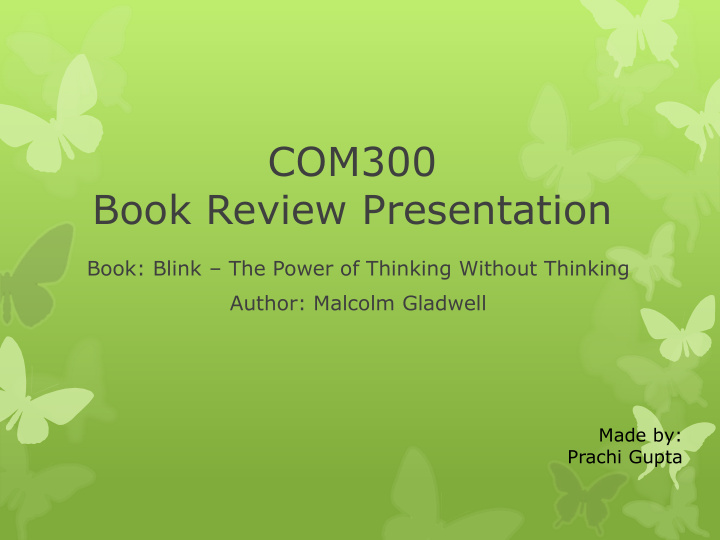



COM300 Book Review Presentation Book: Blink – The Power of Thinking Without Thinking Author: Malcolm Gladwell Made by: Prachi Gupta
Introduction Our brain uses two different strategies to make sense of any situation: 1. Conscious strategy: logical and definitive, but slow 2. Adaptive Unconscious: the brain reaches the conclusions quickly (eg : The ‘knowing how good a p rofessor is’ Experiment by Nalini Ambady) Sometimes we make choices in an instant - in the blink of an eye. We arrive at a decision in the first two seconds after a problem is presented to us. Blink is a book about those first two seconds.
Tasks of the Book The author tries to make us aware of the following three facts through this book: 1. decisions made very quickly can be as good as decisions made cautiously and deliberately 2. when we make a split-second decision, we are vulnerable to being guided by our stereotypes and prejudices, even ones we may not necessarily endorse or believe. 3. our snap judgments and first impressions can be controlled.
The Theory of Thin Slicing Thin-slicing is the ability of our unconscious to find patterns in situations and behavior based on very narrow slices of experience. Eg: The Love Lab Experiment by John Gottman.
The Dark Side of Thin Slicing (The Warren Harding Error) Classic Warren Harding Error - To see someone and let his first impression drown out every other piece of information Eg: Harding elected as the President of the United States based on his looks.
The Delicate Art of Mind Reading Face is an enormously rich source of information about emotion. Expression alone is sufficient to create marked changes in the autonomic nervous system. Whenever we experience a basic emotion, that emotion is automatically expressed by the muscles of the face. That response may linger on the face for just a fraction of a second or be detectable only if electrical sensors are attached to the face. But it’s always there. eg: Difference between a genuine and fake smile
The classic model for understanding what it means to lose the ability to mind-read is the condition of autism. When someone is autistic, he is mind blind. On the most basic neurological level, for someone with autism, a face is just another object. We become temporarily autistic in situations when we run out of time. Training and expertise give us the ability to extract an enormous amount of meaningful information from the very thinnest slice of experience.
The Lesson of Blink Listening with your Eyes Gladwell makes the reader aware of his gut instincts and urges him to trust them more frequently. Taking our powers of rapid cognition seriously means that we have to acknowledge the subtle influences that can alter or undermine or bias the products of our unconscious. My favorite line from the book: “ Prejudging is the kiss of death. You have to give everyone your best shot .”
Thank you!
Recommend
More recommend